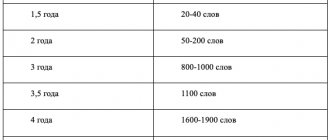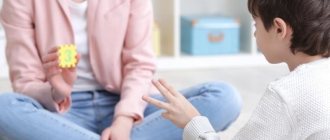Article:
A child’s speech at 1 year of age depends on how the preparatory work for its development was carried out from birth to one year.
Humming, babbling and pronouncing the first words prepared the articulatory apparatus for more complex work; the baby's acquaintance with the objects of his immediate environment enriched his passive vocabulary. At the age of one year, the baby already knows the meanings of many words, the active dictionary contains 10–25 words, and he begins to use speech as a means of communication. He can pronounce words correctly (mama, lalya, baba), babble (pa, ma, bah), partially reproduce the forms of words (“kach” - swing, “zya” - impossible), and imitate the voices of animals and the sounds around him (mu -mu, boo-boo, pee-pee, beep).
At this stage, it is already possible to determine whether there are speech problems. Unlike specialists, it can be difficult for parents to see them, but below we will tell you what signs you can use to independently identify speech problems in your baby.
Passive and active vocabulary
During this period, attention is drawn to such a characteristic feature as imitation of the words of adults. The baby repeats not only familiar words, but also previously unknown ones. These could be words addressed to the child, or words that he heard from others. Such active imitation can be noticed already from 1 year 5 months. Here it is important not to coo with children, faking your speech in “childish” language, but to give an example of the correct pronunciation of words.
Starting from the first year of life, the understanding of words grows; the baby is familiar with the names of objects in his immediate environment, the names of objects, animals and other objects that are most often shown to him in pictures in children's books, on the street. The baby loves to look at bright colored book illustrations. Adults should maintain this interest by choosing clear pictures.
When commenting on illustrations to a child, you need to speak precisely, in simple words, try to denote the object with one, constant word, so that the meaning of the picture is not lost in the stream of speech of an adult. For example, while the word monkey is used to describe monkeys and gorilla.
By the age of one and a half years, a child’s active vocabulary is 20–30 words; its sound composition is still simple. Thanks to the desire to imitate the speech of adults, by the end of the second year the baby increases the number of spoken words tenfold. Speech is dominated by nouns, but there are also verbs (2-3 times less of them) and adverbs (there, here, here).
Occasionally, by the age of two, the use of adjectives can be found in children's speech; this feature will continue to persist into early preschool age. Personal pronouns are often found in a child’s speech and are easily used (I, you, he, she).
Sources
- Wu Y., Li G., Zheng Y. . // Lin Chung Er Bi Yan Hou Tou Jing Wai Ke Za Zhi - 2021 - Vol35 - N4 - p.341-345; PMID:33794634
- Voitenkov VB., Komantsev VN., Klimkin AV., Ekusheva EV., Skripchenko NV., Bedova MA. // Adv Gerontol - 2021 - Vol33 - N5 - p.1002-1006; PMID:33550760
- Liu X., Zhong R., Kusuma L., Li N., Tang W. Determining social power: Do Chinese preschoolers integrate verbal and nonverbal cues? // J Exp Child Psychol - 2021 - Vol204 - NNULL - p.104943; PMID:33360276
- Ganc M., Kobosko J., Jedrzejczak WW., Kochański B., Skarzynski H. Psychomotor development of 4-year-old deaf children with cochlear implants: Three case studies. // Int J Pediatr Otorhinolaryngol - 2021 - Vol141 - NNULL - p.110570; PMID:33348125
- Fordington S., Brown T.H. An evaluation of the Hear Glue Ear mobile application for children aged 2-8 years old with otitis media with effusion. // Digit Health - 2021 - Vol6 - NNULL - p.2055207620966163; PMID:33194218
- Jasińska KK., Shuai L., Lau ANL., Frost S., Landi N., Pugh KR. Functional connectivity in the developing language network in 4-year-old children predicts future reading ability. // Dev Sci - 2021 - Vol24 - N2 - p.e13041; PMID:33032375
- Tan LT., Nathan AM., Jayanath S., Eg KP., Thavagnanam S., Lum LCS., Gan CS., de Bruyne JA. Health-related quality of life and developmental outcome of children on home mechanical ventilation in a developing country: A cross-sectional study. // Pediatr Pulmonol - 2021 - Vol55 - N12 - p.3477-3486; PMID:33002341
- Vilela N., Sanches SGG., Carvallo RMM. Development of auditory perception in preschool children. // Int J Pediatr Otorhinolaryngol - 2021 - Vol129 - NNULL - p.109777; PMID:31756662
- Wang J., Joanisse MF., Booth JR. Neural representations of phonology in temporal cortex scaffold longitudinal reading gains in 5- to 7-year-old children. // Neuroimage - 2021 - Vol207 - NNULL - p.116359; PMID:31733372
- Wu Y., Li G., Ma Y., Zheng Y. . // Lin Chung Er Bi Yan Hou Tou Jing Wai Ke Za Zhi - 2021 - Vol33 - N10 - p.918-922; PMID:31623034
Grammatical structure of speech and sound pronunciation
After one and a half years, the ability to change words in the simplest ways appears, linking them into one phrase (give me a doll - “give me a ku”). Monosyllabic sentences are most often used. In such primitive sentences, one word can be used in different meanings. By pronouncing the word “mu,” in one case the child wants to be given a toy, and in another, with the same word, he draws the adult’s attention to the eyes or horns of the toy cow that he is holding in his hands.
By the end of the second year of life, sentences may contain three or four words. Sentences can be both interrogative and exclamatory. The question words themselves are not yet available to the child; he expresses the question by the intonation with which he pronounces such a sentence. There are no prepositions in the words yet either (“Seva bi-bi” - Seva has a typewriter).
All vowel sounds are already pronounced by the baby in the second year of life. Its articulations and some consonant sounds are available: m, p, k, t, d, n, f, x, b, g, v, y. The clarity of their pronunciation depends on the place of the sound in the word and the number of syllables in it. In simple words of one or two syllables, all sounds are pronounced correctly (Katya, dad, Tanya, Vova). These same sounds are “swallowed” and distorted in more complex words (pisina - machine). Combinations of two consonant sounds next to each other (heb - bread) are also difficult for the baby, especially if these are sounds that are difficult to pronounce, for example: s, sh, r, l.
Different rates of speech acquisition by children of the same age become noticeable. This depends on the individual characteristics of the baby, heredity, and diseases suffered in early childhood. Of great importance is the intensity of communication between adults and the child, how the child’s speech development is stimulated at 1 year of age.
Norms of speech development in the second year of a baby’s life
Assessing a child’s speech at one year of age is very problematic: the guidelines for its development are very arbitrary and a delay in speech activity is acceptable. You can give approximate norms at the end of the second year of life:
- the baby answers simple questions;
- he can carry out a simple order, for example, take a cup to his grandmother, give him an item or a toy;
- the child easily repeats simple phrases and simple words after adults;
- all vowels and most consonants are available to its pronunciation;
- by the age of one and a half years, the baby combines two words into a sentence, and by two years, he constructs a sentence of 3–4 words;
- he actively and on his own initiative enters into communication with other children and familiar adults;
- he can ask a question using intonation;
- the child is able to pronounce at least 50 words, more often 200–300;
- begins to use singular and plural nouns (cube - cubes), diminutive suffixes (house - house);
- he can understand and follow two-step instructions: “Take the spoon on the table and take it to dad”;
- the baby can show two or three parts of the body or more;
- listens to nursery rhymes, fairy tales, poems, tries to remember small pieces.
If in the list above you see an item that your baby does not meet, it is worth closely observing the child, assessing whether he strives to communicate with others, whether he understands speech addressed to him. It is possible that the baby has a slight delay in speech development.
Speech therapist advice
In order for your baby to master the speaking process earlier and quickly move from babbling to full understandable words, it is necessary to follow a number of rules:
- Do not talk for a long time, copying the speech of a baby (yeah, yeah). As soon as the baby begins to master the first words, you should stop baby talk and speak correctly.
- The pacifier should be removed from use after 1 year, maximum 1.5. It slows down speech development, prevents you from speaking more, even a child’s crying is part of speech.
- Encourage your baby to blow the whistle, blow soap bubbles, and play whistles, which stimulates the development of the articulatory apparatus.
- Play the “monkey” game with the baby, when he must repeat various grimaces after the parent: puff out his cheeks, suck in his lips, smile, etc.
- Do more modeling, drawing, and cutting with your child. Let the baby glue, rearrange, move, and collect various objects. The parent’s task is to pronounce the shape, color, and sound.
- Teach children to express their own emotions through speech, even if initially these are simple words: oh, yes, yeah, uh.
- Read more fairy tales. It is better to choose books with bright illustrations. It is difficult to keep a child under 2 years old in one place for a long time and listen to a fairy tale to the end. Colorful pictures will help you concentrate, listen to an adult read, and follow the story.
A child’s speech is formed before the age of 3. Until this age, children are not required to read poetry aloud, but they must begin to speak at the age of one. Each baby is individual, speech development is a process that is easier for some to comprehend and more difficult for others. It is important not to lose hope, to work with children from birth to one year, to actively talk with the baby, read fairy tales, and play. Joint activity with an adult is a powerful stimulus for the development of speech activity.
Symptoms of delayed speech development in a baby
How to understand that a one-year-old child has a delay in speech development? This question interests many parents, and often moms and dads rush from one extreme to another. Some, seeing how their child’s peers express themselves fluently and freely, anxiously listen to the speech of their child, who has not mastered even half of this vocabulary. Others, relying on the stories of those who tell how their silent children suddenly spoke at 3, 5, 6 years old, do nothing and wait for the same miracle, and then face the problem of a serious delay in the development of their baby.
The age from one to two years is a kind of milestone when it becomes clear whether a child’s speech is developing normally, or whether the child has one of the following pathologies:
- motor alalia
- sensory alalia,
- dysarthria,
- aphasia,
- rhinolalia,
- hearing loss, or lack of hearing,
- delayed speech development,
- general speech underdevelopment.
At two years old, it is necessary to have your baby examined by a specialist if he has the following symptoms:
- the child is silent or babbles in one language he understands;
- when asked what his name is, he turns away;
- the baby does not turn to an adult when he needs something, but hums or points with his finger;
- the child understands what is said to him, but cannot formulate the statement himself;
- at first speech appeared, there were words or even phrases in it, and then it disappeared, and the child practically fell silent;
- by 2 years of age there are almost no words in speech.
Based on the results of the examination, at two years of age it is advisable to begin stimulating speech development, and parents themselves can make significant progress in this direction. Many simply do not know what and how to do, so it is recommended to go for a consultation with a speech therapist, psychologist or defectologist - you can work with them from the age of 2.
Motor activity of the child
What a one-year-old child can do cannot be compared with his skills just a few months ago. He has already learned much better how to handle his own body, he is very active, moves a lot and in a variety of ways. The baby can calmly hold two objects in his hands, can assemble a pyramid, or even hold a spoon at the table while feeding. Of course, in many activities he still needs the help of his parents: such young children are able to concentrate on something for only a few minutes.
Active movements.
The child crawls, stands on his legs, including from a squatting position, and gets up on his knees independently. He can climb on or off a chair or sofa, and with the help of his parents, he can go up or down the stairs. Children are very inquisitive, so at this age they should not be left near open windows or dangerous objects. The kid can figure out how to get to the windowsill using a chair. Fine motor skills become much better: the child can pick up a small object with two fingers, take a cup and drink from it.
Dancing.
Little children love music. Many people notice that, having heard an interesting melody, the baby begins to dance actively: he likes it. Some not only dance, but also try to sing along to children's songs. If the child does not do this, you can show him a simple dance, and he will begin to repeat without prompting from mom or dad.
Moving quickly on all fours
. Almost all babies at this age are already crawling, and quite quickly. Some skip the stage of walking on all fours and immediately stand on their feet, but this does not happen for everyone. Most often, a one-year-old child moves calmly by crawling.
Walking with parental support.
Some children are already starting to take their first steps. Few people begin to walk independently, but most babies can already walk unsteadily while holding mom or dad’s hand. Some people try to walk while holding onto walls or other support. However, there are also children who are in no hurry to start walking on two legs, and this is completely normal. If your child has not gone yet, there is no need to rush him. Dr. Komarovsky suggests that in such cases, holding off on walking may even be useful: walking upright is a serious load on the back, and perhaps the baby is simply not ready for it yet [1].
Self-diagnosis of speech delay
Without being specialists, parents are unlikely to be able to independently determine the cause of the speech defect. They only have access to simple diagnostics. Parents can determine:
- Is the baby's hearing impaired?
- What is the state of the child’s gross and fine motor skills?
- whether the mobility of his articulation organs is preserved,
- to what extent he understands the speech addressed to him.
Hearing test
Hearing impairment is a significant cause of delayed speech development. Without hearing the correct pronunciation of words, the baby will not be able to pronounce them. You can suspect such a pathology if the following symptoms appear over the course of a year:
- the baby does not respond to quiet sounds that are heard outside his field of vision;
- it does not turn towards the source of the sound;
- the child does not show interest in music, the sounds of operating household appliances, electronics;
- the baby does not understand when he is addressed;
- he does not imitate onomatopoeia, there is no babble or simple words in his speech;
- the child does not use his voice to attract the attention of adults.
If you have doubts, you can check your baby’s hearing yourself. To do this, you need an adult assistant and a separate room, protected from extraneous noise. The baby should be invited to play with sounding toys with his mother. Next, the adult uses them to make sounds behind the baby’s back at a distance of at least 6 meters, so that he does not see the source of the noise. If there is no reaction, the distance is reduced by one meter, getting closer to the child with each stage.
You can start the examination by whispering behind the baby’s back, depicting an unusual combination of sounds that should attract the child’s attention. Then these sounds or the baby’s name are repeated in a voice at normal volume. The same procedure is carried out a few days later. If you suspect absence or decreased hearing, you should show the child to an otolaryngologist.
Diagnostics of fine and gross motor skills
It is not for nothing that such great importance is attached to the examination of motor skills. The areas of the brain responsible for the development of speech and fine motor skills of the child are located next to each other. There are no problems with fine motor skills, which means that the mechanisms of speech emergence are preserved, and, most likely, the problem does not lie in the field of neuropathology. Uncertain and uncoordinated movements, inability to make precise movements with the hand and fingers - you need a consultation with a neurologist and a thorough diagnosis.
Indicators of the development of general motor skills by the end of the child’s second year of life:
- He can run;
- climbs stairs well, stepping on each step in turn with one foot;
- jumps up low or jumps over a very low obstacle;
- kicks the ball;
- steps over objects;
- marches, although not too deftly;
- may back away.
Achievements in the development of fine motor skills in a two-year-old child:
- tries to stop the ball rolling towards him;
- he can stack from 4 to 6 cubes on top of each other (“building a tower”);
- the child draws vertical lines or simply “doodles,” although he often holds the pencil or felt-tip pen incorrectly;
- he has a well-developed “tweezer grip,” when the baby takes very small parts of toys or pieces of food with two fingers;
- he strings the rings of the pyramid onto the pin of the stand;
- tears small pieces from a sheet of paper or a piece of plasticine.
To determine the level of development of motor skills, there is no need to organize a special examination; it is enough to carefully observe the child’s movements while awake.
Diagnostics of articulation organs
Anomalies in the structure of the speech organs and impaired mobility can affect the ability to pronounce certain groups of sounds. To detect pathology, it is enough to check the structure of the tongue, jaws, lips, and palate.
Possible problems:
- progeny - the lower jaw is pushed far forward relative to the upper jaw;
- prognathia – the upper jaw protrudes forward;
- open bite - a gap is visible between the closed teeth;
- high and narrow palate (“Gothic”);
- shortened frenulum of the tongue, it is difficult for the baby to lift the tongue upward, it begins to bifurcate in the child like a snake;
- massive or very small tongue.
In addition to these defects, parents may notice increased salivation, tongue trembling, limp lips, and a constantly slightly open mouth. If you have such symptoms, you should immediately contact a specialist. Failure to carry out timely corrective measures can lead to the development of mental retardation and even mental retardation.
Testing speech understanding
To make sure that the child understands the speech addressed to him, he is asked to complete several tasks in a playful way:
- offer to choose one toy from several laid out in front of the baby;
- understands and selects red, yellow, blue and green objects;
- assemble a matryoshka or pyramid
- ask to show things that he uses in everyday life: a spoon, a cup, a chair, slippers;
- offer to show yourself or the doll body parts;
- ask to find an object or action in the picture (they can be cut out from unnecessary magazines and pasted on cardboard);
- offer to fulfill a simple request: bring a book, come closer, give a toy.
The absence of defects in the organs of articulation and understanding of the speech of others with underdevelopment of speech skills may indicate a tempo delay in speech or general underdevelopment of speech. Stimulating classes with a specialist, started as early as possible, will help overcome the gap with peers.
Nimble fingers
Training fine finger movements has a great influence on the development of a child’s active speech. This phenomenon has long been known to psychologists and speech therapists. And they never tire of repeating how important it is to develop fine motor skills. A variety of finger games, manipulations with paper (it can be torn into small pieces, crumpled, crumpled), and unscrewing and tightening the lids on cans and bottles will help with this.
As always, an inexhaustible resource in this regard is an ordinary kitchen. My child, for example, really liked hiding small toys from Kinder Surprises in a bowl of dry peas or lentils, and then finding them by touch (be careful, Kinder Surprises often contain small parts that, of course, should not be given to the baby). The peas gently massage little fingers, and the baby receives many pleasant tactile sensations. Try it yourself!
You can draw with your fingers on a tray on which a thin layer of flour or semolina is sprinkled. You can play with cotton swabs, taking them out of the jar one at a time and then putting them back in. You can attach colorful clothespins to a plastic jar or box, and then unhook them and throw them into the same jar.
Look around, and perhaps you will find a new interesting and useful activity for your little one.









